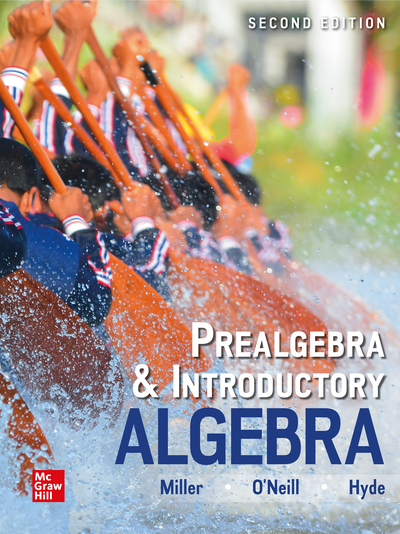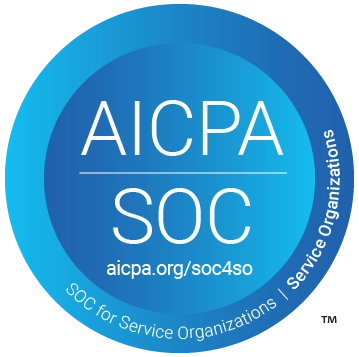Log In to My PreK-12 Platform


Prealgebra & Introductory Algebra, 2nd Edition
Format Options:
-
Lowest Price!
eBook from $59.00 -
Print from $70.00 -
ALEKS from $257.45
McGraw Hill eBook
Textbook Rental (150 Days Access)
- Rent for a fraction of the printed textbook price
- Complete text bound in hardcover or softcover
Loose-Leaf Purchase
Unbound loose-leaf version of full text
Shipping Options
- Standard
- Next-day air
- 2nd-day air
Orders within the United States are shipped via FedEx or UPS Ground. For shipments to locations outside of the U.S., only standard shipping is available. All shipping options assume the product is available and that processing an order takes 24 to 48 hours prior to shipping.
* The estimated amount of time this product will be on the market is based on a number of factors, including faculty input to instructional design and the prior revision cycle and updates to academic research-which typically results in a revision cycle ranging from every two to four years for this product. Pricing subject to change at any time.
Instructor Information
Quick Actions (Only for Validated Instructor Accounts):
Create more lightbulb moments with this comprehensive set of valuable content and insightful, intuitive digital learning resources! This new 2nd edition of the Miller/O'Neill/Hyde Prealgebra and Introductory Algebra text seeks to serve the changing dynamics of today's curriculum by thoughtfully interweaving the topics of two foundational building blocks in students' mathematical journey. The text reflects the compassion of its experienced author team with features developed to address the specific needs of today's prealgebra and introductory algebra students. Included alongside the highly-favorable Problem Recognition Exercises, readers will find added review material, aimed at assisting students with synthesis, summarization, and recognition of key mathematical topics so as to enhance their overall conceptual understanding. These types of exercises, along with the overall number of practice problems and group activities available, permit instructors to choose from a wealth of problems, allowing ample opportunity for students to practice what they learn in lecture to hone their skills.
About the Author
Julie Miller
Julie Miller is from Daytona State College, where she has taught developmental and upper-level mathematics courses for 20 years. Prior to her work at Daytona State College, she worked as a software engineer for General Electric in the area of flight and radar simulation. Julie earned a bachelor of science in applied mathematics from Union College in Schenectady, New York, and a master of science in mathematics from the University of Florida. In addition to this textbook, she has authored several course supplements for college algebra, trigonometry, and precalculus, as well as several short works of fiction and nonfiction for young readers.
My father is a medical researcher, and I got hooked on math and science when I was young and would visit his laboratory. I can remember using graph paper to plot data points for his experiments and doing simple calculations. He would then tell me what the peaks and features in the graph meant in the context of his experiment. I think that applications and hands-on experience made math come alive for me and I’d like to see math come alive for my students.
Molly O'Neill
Molly ONeill is from Daytona State College, where she has taught for 22 years in the School of Mathematics. She has taught a variety of courses from developmental mathematics to calculus. Before she came to Florida, Molly taught as an adjunct instructor at the University of Michigan-Dearborn, Eastern Michigan University, Wayne State University, and Oakland Community College. Molly earned a bachelor of science in mathematics and a master of arts and teaching from Western Michigan University in Kalamazoo, Michigan. Besides this textbook, she has authored several course supplements for college algebra, trigonometry, and precalculus and has reviewed texts for developmental mathematics.
I differ from many of my colleagues in that math was not always easy for me. But in seventh grade I had a teacher who taught me that if I follow the rules of mathematics, even I could solve math problems. Once I understood this, I enjoyed math to the point of choosing it for my career. I now have the greatest job because I get to do math every day and I have the opportunity to influence my students just as I was influenced. Authoring these texts has given me another avenue to reach even more students.
Nancy Hyde
Nancy Hyde served as a full-time faculty member of the Mathematics Department at Broward College for 24 years. During this time she taught the full spectrum of courses from developmental math through differential equations. She received a bachelor of science degree in math education from Florida State University and a master’s degree in math education from Florida Atlantic University. She has conducted workshops and seminars for both students and teachers on the use of technology in the classroom. In addition to this textbook, she has authored a graphing calculator supplement for College Algebra. I grew up in Brevard County, Florida, where my father worked at Cape Canaveral. I was always excited by mathematics and physics in relation to the space program. As I studied higher levels of mathematics I became more intrigued by its abstract nature and infinite possibilities. It is enjoyable and rewarding to convey this perspective to students while helping them to understand mathematics.
Accessibility
Creating accessible products is a priority for McGraw Hill. We make accessibility and adhering to WCAG AA guidelines a part of our day-to-day development efforts and product roadmaps.
For more information, visit our accessibility page, or contact us at accessibility@mheducation.com
Need support? We're here to help - Get real-world support and resources every step of the way.

